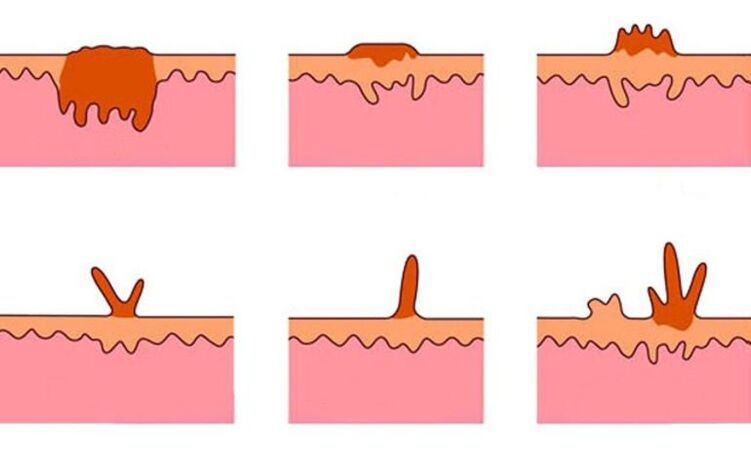When nipple-like growths appear on the torso, limbs or face, it is always an unpleasant surprise for a person. These are benign formations on the skin, which can be multiple or single. Unfortunately, papillomas on the body are a very common disease that develops due to infection with the human papillomavirus (HPV), but their treatment in modern conditions is not a problem.

What are papillomas?
The human papillomavirus includes more than 600 varieties of strains (a culture of microorganisms of a certain type, derived from a specific source and having characteristic properties), under the influence of which various categories of papillomas are formed. In medical practice, it is customary to divide the types and types of papillomas according to their origin, appearance, how quickly they grow and where they are located. Certain papillomatous growths appear in the intraoral cavity, vagina, penis, and bladder area.
Identification of the papilloma classification is very necessary from the point of view of choosing the appropriate treatment method and analyzing the possible evolution of the papilloma into a malignant neoplasm.
Papilloma is a benign skin tumor whose structure contains blood vessels and connective tissue covered by epithelium, which grows upwards and outwards.
Types of papillomas
There are several varieties of these formations. There are more than 100 types of papillomas, characterized by individual features.In most cases, the following types are diagnosed:
| Name | Description |
|---|---|
| Simple | Compacted growths with a smooth, semicircular surface. They usually occur on the fingers, hands and, in rare cases, the knees. Similar formations appear in childhood and adolescence. They usually disappear on their own, without leaving any consequences. |
| Flat | Formations that have a round shape. They are easy to notice visually as they rise above the skin. They often provoke the occurrence of various inflammatory processes, in which people complain of itching and burning. Usually detected almost immediately after appearance |
| To plant | Papillomas, which in the early stages of development people often confuse with calluses. After some time, the edges of the formation form and the center of the papilloma can be distinguished. When walking, people feel severe discomfort, and sometimes pain appears. An alternative name for these papillomas is spines. |
| filiform | Elongated growths, similar to several connected threads. It usually develops in old age. The most popular localization areas: neck region, under the arms, near the eyes. Due to their strange shape, they are characterized by a high risk of injury |
| Condylomata acuminatum | Papillomas located on the mucous membrane. They are characterized by the highest degree of danger, since there is an increased risk of malignancy. Urgent elimination of these formations is necessary. If such growths are detected, you should immediately consult a doctor. |

Based on external signs, a specific papilloma can be attributed to a specific group. To accurately determine the type of papilloma and the cause of its appearance, it is necessary to undergo a complete examination and the help of a specialist.
Causes of papillomas
According to medical statistics, today almost 90% of people are carriers of the human papillomavirus, which is the main cause of papilloma. This viral disease exists in the body for a long time without showing any external signs. However, various internal infections and viruses, exacerbation of chronic diseases, abnormal nutrition and constant stressful situations suppress the immune system and provoke the formation of papilloma-like growths on the skin.
Among women
An increase in virus activity can occur due to a specific number of reasons. Papillomas often form during pregnancy, since during pregnancy there is a sharp decrease in immunity and a deterioration in the state of the body. The acceleration of its growth is influenced by pathologies in the production of hormones, which manifest themselves not only during pregnancy, but also due to the constant use of contraceptives. Some scientists talk about an innate predisposition to the formation of papillomas. This factor often influences the occurrence of genital warts.

In men
When the virus enters the male body, its development in a person with strong immunity is suppressed. Therefore, the carrier of the disease may not be aware of the infection for a long time (from two weeks to several years). The main reason why papillomas appear on the body is the activation of a dormant virus.
Often, papillomas occur in the mouth, larynx and trachea.
Risk factors
HPV infection, as well as exacerbation of the disease, can occur under the influence of such factors:
- A sharp decrease in immunity, weakening of the entire body.
- Constant stress, nervous shock, prolonged depression.
- Smoking, frequent consumption of alcoholic beverages and other bad habits.
- Infectious diseases, including ARVI, flu.
- Gastrointestinal problems.
- Active sex life.
- The use of certain medications, especially antibiotics.
- Visit public places characterized by high humidity: saunas, baths, swimming pools, beaches.
Locations of papillomas
The most common in medical practice are filiform, vulgar or genital papillomas, in addition to condylomas.
Filiform warts are located on the face, vulgar warts are more frequently located on the feet or hands and condylomas are located exclusively on the mucous membranes (head of the penis and urethra in men, in the area of the labia minora and vagina in women), but it turns out that any of these warts can appear in an unusual location.
Removing these papillomas is not difficult in modern conditions, but the danger lies in the fact that with a decrease in immunity, new papillomas may reappear, which will lead to more serious health consequences, for example, the subsequent occurrence of condylomas is fraught with the development of cervical cancer in women.
Plantar warts most often appear on the rough soles and soles of the toes. Sometimes a pimple may appear on the thumb after serious damage to the skin in that area.
In general, papillomatosis is a widespread form of pathology in which neoplasms form throughout the human body. These growths have a characteristic appearance, therefore, once the manifestations of the disease are observed, it can no longer be confused with any other disease.
Danger
Papillomas are benign neoplasms, but present a risk of malignancy. If the papilloma suddenly increases in size and causes concern, it is necessary to undergo tests to exclude malignant neoplasms. The most prone to degeneration are papillomas that form on mucous membranes. Formations that are not treated for a long time are more susceptible to malignancy.
Areas of the body where the papilloma was incorrectly removed are at high risk of degeneration into cancerous tumors.
Dangerous consequences that occur if you refuse treatment for papillomas:
- Degeneration of genital warts located in the vagina. There is a risk of cervical cancer. This process lasts a long time, but the disease does not manifest itself with characteristic symptoms. If you do not carry out preventive examinations, it is almost impossible to identify violations. The pathology appears only in the last stages.
- If the papilloma is damaged, there is a possibility that the infection will spread to undamaged areas. There is a risk of formation of growths located close to each other. If you notice such disorders, you need to pay attention to increased virus activity and undergo symptomatic treatment.
Papilloma virus treatment:
- Antiviral and immunomodulatory therapy;
- Laser removal;
- Treatment of viral papillomas with nitrogen (cryodestruction);
- Radio wave treatment method.
Papilloma prevention
According to medical research, the prevalence of HPV in the population over 50 years of age is at least 75%. There are many conditions under which the papillomavirus is transmitted. Prevention of infection becomes evident already in the study phase of papillomavirus transmission routes.
Wart prevention should be based on the following recommendations:
- You should not walk barefoot in public places with high levels of heat and humidity, as the human papillomavirus may be on the surface of the floor, as plantar warts are very contagious;
- it is necessary to minimize the number of physical contacts with an infected person, also avoiding the use of their personal belongings;
- During intimate contacts, you must use a condom (unfortunately, this method does not give a 100% guarantee, but it significantly reduces the likelihood of infection).
Prevention of papilloma at home should be aimed at following the rules of personal hygiene, airing shoes, disinfecting bathrooms after visiting them by other people.























